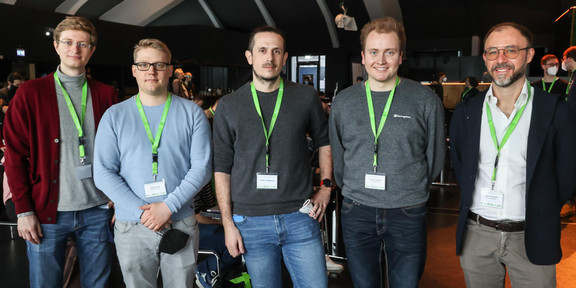Interface opens way to efficient Catalysts
- News
- Research

Enzymes are essential for almost all metabolic processes in cells that require catalysis. Inspired by nature, such enzymes can serve as blueprints for the development of new, synthetic catalysts with high efficiency. The Dortmund physicists led by Prof. Cinchetti are particularly interested in interfaces formed between metals and molecules, which enable enzymes to act as catalysts. One example is a porphyrin-metal interface. Porphyrins are molecules that are involved in vital processes such as photosynthesis or oxygen transport in the human bloodstream.
The research group has now succeeded in creating such a metal-organic interface by vapour-depositing nickel porphyrins on a copper surface. The nickel ions in the centre of the molecules form a well-ordered lattice structure. Such a 2D lattice has two major advantages. The nickel ions, which have identical chemical and physical properties, can be used as single-atom catalysts and are therefore particularly powerful. In addition, the structure creates a uniform interface where the catalytic properties are very evenly distributed.
Interface enables decomposition of nitrogen monoxide
The researchers then tested the performance of this developed interface by exposing it to nitric oxide (NO). Nitric oxide is a toxic and polluting gas emitted by cars, trucks and other vehicles. The data suggest that the interface allows three nitrogen monoxide molecules to decompose into one nitrous oxide (N2O) molecule and one nitrogen dioxide (NO2) molecule through a chemical reaction (disproportionation reaction). While the former is not toxic and is used in medicine as an anaesthetic and painkiller, the latter is mainly used in the production of fertiliser. In addition, it was shown that the nitrogen dioxide molecules initially remain anchored to the nickel network after the reaction, but can be removed by subsequently heating the system.
"The developed system represents an example of a biomimetic interface at which natural processes can be modelled and understood in order to develop other classes of two-dimensional catalysts with high efficiency and selectivity in the future," says Dr. Giovanni Zamborlini, a research associate in Prof. Mirko Cinchetti's research group. These catalysts can be used in many different areas, for example in the refining of petroleum or in the processing of foodstuffs.
The work is the result of an international cooperation between the Technical University of Dortmund, the Research Centre Jülich, the University of Trieste, the University of Erlangen-Nuremberg and the University of Graz.
Contact for queries:









